
Windows
Windows which allow optical radiations to pass from one environment to other, without allowing other elements of these environments to mix. Considerations in selecting windows include transmission, scattering, wavefront distortion, resistance to environmental conditions like temperature, chemical resistance etc.The windows are available in circular and rectangular aperture. The accuracy of rectangular aperture windows will match the accuracy of circular window of diameter nearest to the diagonal of the window.
Diameter : + 0.25mm
Thickness : + 0.2mm
Frame Material : BK7, Fused Silica
...more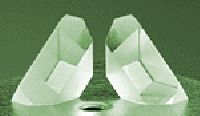
Roof Prism
Roof Prism It is a right-angle prism whose hypotenuse has been replaced by a 90o TIR roof. The 90o deviation applies only to rays, which are precisely normal to the entrance and exit faces, other rays being deflected by other amounts. They are ideal for use in spotting scopes, and any optical instrument where it is desirable to take an inverted image from an objective, turn it right side up, and bent it through a 90o angle, to maintain the correct visual orientation.
...more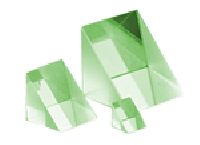
Right Angle Prism
Right Angle Prism It is usually preferred over an inclined mirror as it is easy to mount and can handle external mechanical stresses.Very high transmission can be achieved by using the hypotenuse face in Total Internal Reflection mode and with entrance and exit surface anti reflection coated.If the hypotenuse faces may not be kept clean due to environmental conditions it is advisable to aluminize hypotenuse surface.
Material : BK7 or Fused Silica
Size : From 2mm to 50mm
...more
Retroreflector
Retroreflector It reflects any ray or beam entering the prism face, regardless of the orientation of the prism, back onto itself. It is used in where the precision alignment is difficult or time-consuming, and also function even at very large angles of incidence.
...more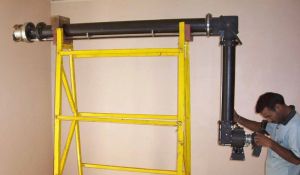
Radiation Resistant Viewing System
Radiation Resistant Viewing System of irradiated material are prepared in Hot Cells. Various optical devices are used for process control and inspection. Periscopes may be used to view and photograph a wide region inside a Hot Cell within an area of 180o centered around the objective end.
...more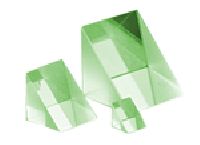
Precision Right Angle Prism
Precision Right Angle Prism It is usually preferred over an inclined mirror as it is easy to mount and can handle external mechanical stresses. Very high transmission can be achieved by using the hypotenuse face in Total Internal Reflection mode and with entrance and exit surface anti reflection coated. If the hypotenuse faces may not be kept clean due to environmental conditions it is advisable to aluminize hypotenuse surface.
...more
Plano Convex Lens(Pcx)
Plano Convex Lens(PCX) They can form virtual image as well, depending on the object distance, so as to use in magnifier configuration. They converge incident light to form real image, suitable for imaging application. Condensers can be made using two PCX lenses of same or different focal lengths (depending on the ), with two convex sides facing each other. Such configuration is better than a single doublet, as the spherical aberrations are minimized.
...more
Plano Concave (PCV) Lens
Plano Concave (PCV) Lens The lens has negative focal length, diverges collimated light and hence used for beam expansion. It has minimum spherical aberration for negative-infinite near-infinite conjugates, when concave surface faces the infinite conjugate. A convergent beam incident on plane surface is transformed into collimated beam with least additional spherical aberration.
...more
Penta Prism
Penta Prism is neither inverted nor reversed as it is deviated by 90o, It is a constant deviation prism, i.e. slight movement of the prism does not affect the true right angle at which light rays are reflected. It shortens the optical path length of an instrument.
...more
Optical Mounts
Self-Centering lensoptics mounts, Universal Adjustable lens, Multiple filter holder,Push holder, Universal plate holder, Bar clamp, spring clamp.
...more
Optical Mirrors
We are one of the LEADING SUPPLIERS of Optical Displays and Solutions. We are MANUFACTURERS & EXPORTERS of Optical Display Solutions in India. We provide CUSTOMIZED Solutions.
...more
Optical Flat
Optical Flat is a precisely polished flat surface, used as a reference, against which flatness of an unknown surface may be compared. When an optical flat is placed on a polished flat surface, with a monochromatic light incident on it, dark and light fringe pattern, called interference pattern is visible. The shape of the fringes gives the visual representation of the flatness of the surface under test.
...more
Neutral Density Filters
Neutral Density Filters Flat spectral transmission between 400-700nm, Can be stacked to create intermediate optical densities. OD of stack is sum of OD of each filter. Transmissionreflection ratio varies with density. Place mirrored surface towards light source
...more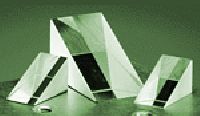
Littrow Prism
Littrow Prism It is used as the planar element of a hemispherical laser resonator. The base is mirror coated for reflection. Single layer magnesium fluoride anti reflection coating with peak at 550nm. Multi-layer dielectric antireflection coating
...more
Laser Optics

Laser Mirrors
Reflector for Laser Machine offered comes in high quality construction finish and provide for active working support in ensuring precise cutting of laser machines. Further, these laser cut acrylic mirrors are of 25mm and come with silicon reflecting support. The use of silicon material make these provide for high reflecting properties of 99.9%. Here, our expertise also lies in offering OEM solutions as demanded from the customers.
...more
Equilateral Prism
Equilateral Prism It is used as dispersing element in instruments and experiments, which requires wavelength separation. It has three equal 60o angles.
...more
Dove Prism
These prisms are used as image rotators. When the prism is rotated, the image passing through will rotate at twice the angular rate of the prism. The hypotenuse face of a dove prism is the face of the largest area. This prism is used in the total internal reflection(TIR) mode, with unaluminized hypotenuse face.
...more
Double Convex (DCX)
Double Convex (DCX) They converge incident light to form real image, suitable for imaging application. May be recommended for virtual image of real objects, so as to use in magnifier configuration. When short focal length is more important than image sharpness then for the same diameter of PCX lens a DCV lens is prefered.
...more
Double Concave (DCV) Lens
Double Concave (DCV) Lens The lens has negative focal length, diverges collimated light and hence used for beam expansion. It has minimum spherical aberration for negative-infinite near-infinite conjugates, when concave surface faces the infinite conjugate.A convergent beam incident on plane surface is transformed into collimated beam with least additional spherical aberration.
...more
Cylindrical Lens
Cylindrical Lens The lenses are used in applications requiring magnifications in one dimensions only, such as in transforming a point image into a line image, or changing the height of an image without changing its with. It finds its application in focusing a line on a slit or converging light for a line scan detector, or used as laser line generator. The cylindrical lenses are made with a rectangular aperture, but may be rounded to give a circular aperture, for the ease of mounting and changing the orientation.
Material : BK7 or Fused Silica
...more
Ball Lens
Ideal for fiber optic application, involving focusing of light in fiber or fiber coupling. Available in variety of material like BK7, SF11, quartz and ruby. As the ratio of diameter of beam entering the lens (d) to the diameter of the ball (D) increases the back focal length increases. It is desirable to have low back focal length for fiber coupling application, and so high index glass is preferred. However, quartz ball lenses are preferred for their chemical stability. Ruby lenses are best suited for harsh atmosphere like datum spheres etc.
Diameter : 2mm- 25mm
...more
Optical Instruments

Precision Optics
Opening Hours